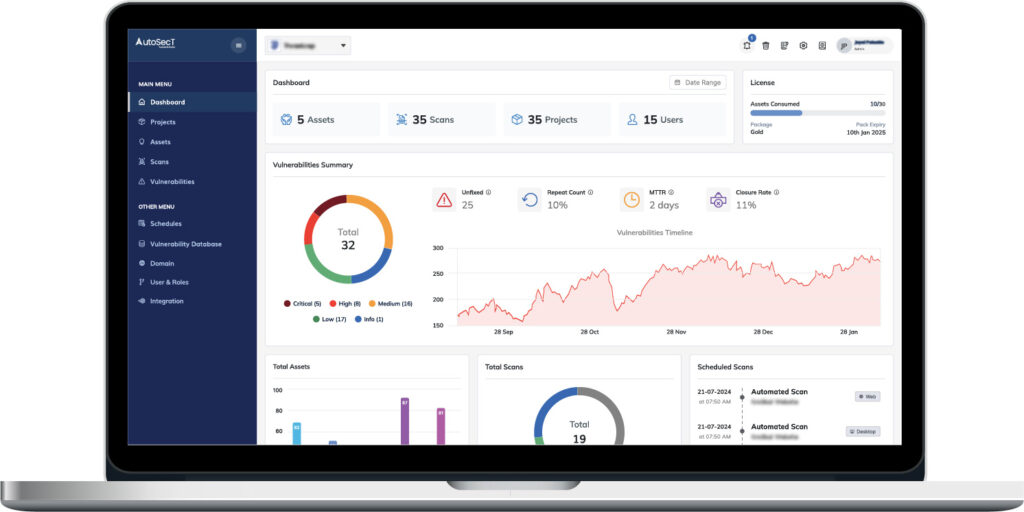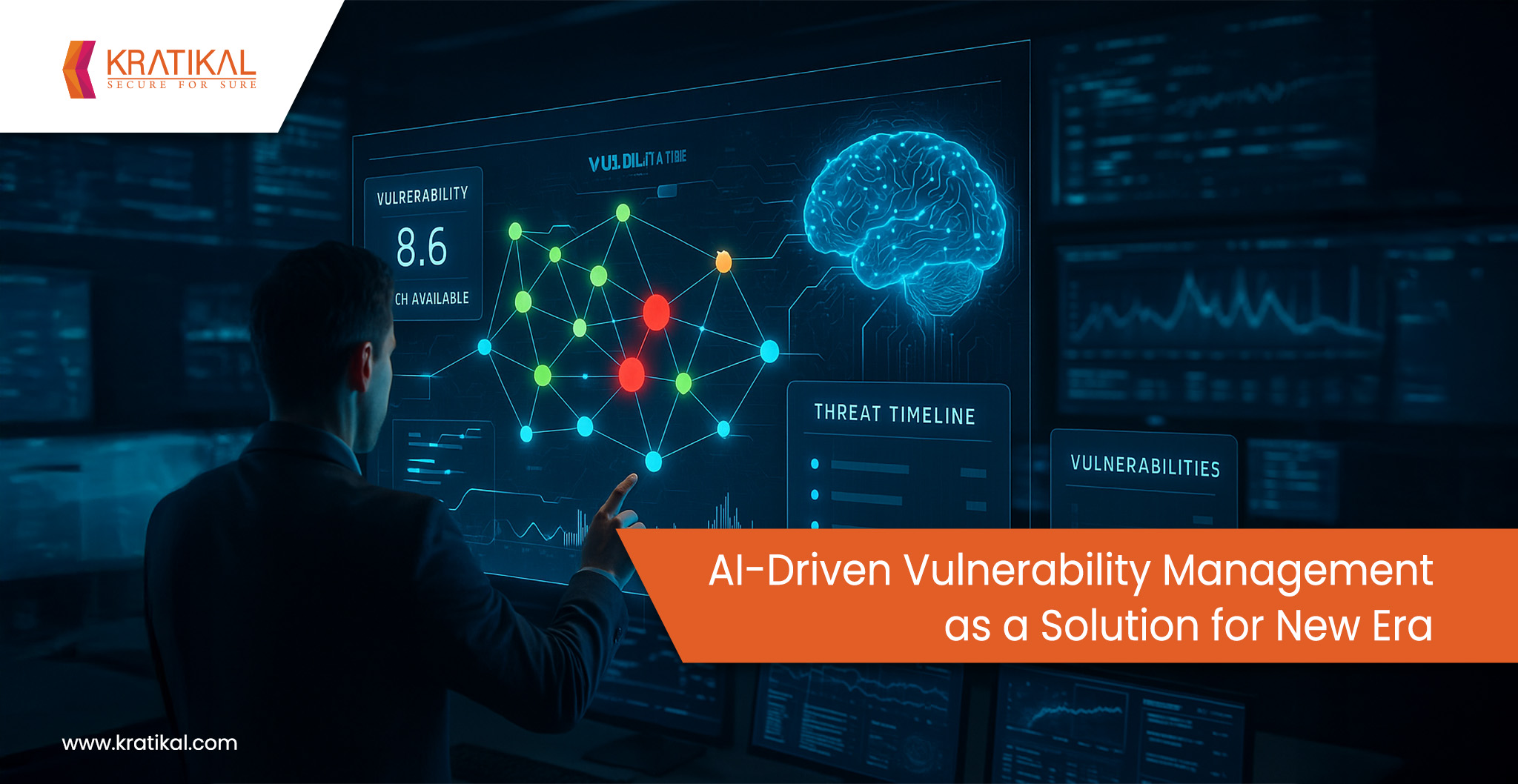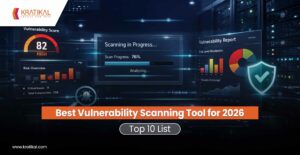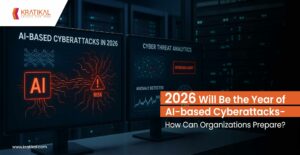Vulnerability management (VM) is the continuous process of finding, evaluating, listing, reporting, and providing AI-driven patch recommendations for security vulnerabilities across an organization’s inventory. In practice, this means regularly scanning IT assets for known vulnerabilities, prioritizing which ones to fix first, and providing customised recommendations based on the vulnerabilities found before attackers can exploit them. Vulnerability management as a solution comprises threat intelligence and knowledge of business context to prioritize risks and address vulnerabilities at the earliest. This solution is critical in modern cybersecurity because unpatched vulnerabilities remain one of the primary causes of security breaches.
78% of cyber attacks target vulnerabilities with patches already available, underscoring how many incidents could be prevented with timely updates! Not only that, with tens of thousands of new vulnerabilities disclosed each year, organizations are struggling to keep up. Every unaddressed weakness is a potential entry point for threat actors, making comprehensive vulnerability management a fundamental pillar of cyber defense. Therefore, this article dissects the importance of AI-driven vulnerability management as a solution:
Table of Contents
Why AI-Driven Vulnerability Management as a Solution?
AI and machine learning are revolutionizing vulnerability management by addressing the scale, speed, and complexity issues that make traditional methods not so effective. Moreover, AI-driven vulnerability management completely rejuvenates the conventional process, which usually relies on signature databases, CVSS scores, and manual analysis with intelligent automation and data-driven decision-making. Below, we have listed several core importance of AI-driven vulnerability management as a solution, focusing on technical benefits like improved threat detection, risk prioritization, response times, and predictive analytics:
Enhanced Threat Detection and Analysis
AI excels at sifting through massive amounts of data to uncover security issues that might otherwise go unnoticed. This capability enables faster and more thorough vulnerability detection. For example, machine learning models can analyze software code or system logs to identify anomalous patterns or misconfigurations indicative of a vulnerability, even if that issue has no known signature yet.
By processing data at high speed and in near real-time, AI-driven systems can spot dangerous conditions or newly introduced CVEs much sooner than manual reviews or periodic scans. This real-time monitoring means vulnerabilities or suspicious activities are flagged as they arise, reducing an attacker’s dwell time on the network. AI-based scanners also tend to produce fewer false positives by learning from feedback and refining their detection rules, which helps security teams focus on genuine issues instead of wasting time on noise. In short, AI’s pattern recognition and anomaly detection capabilities significantly boost the coverage and speed of vulnerability identification, helping catch threats that traditional tools might miss.
Smarter Risk Prioritization with AI/ML
One of the most impactful improvements of incorporating AI-driven vulnerability management as a solution is risk-based prioritization. This is because not all vulnerabilities pose equal risk; factors like exploitability in the wild, asset criticality, and threat context determine which flaws are most dangerous. AI can dynamically analyze these factors to rank vulnerabilities more intelligently than a static severity score alone. For instance, modern platforms leverage machine learning to predict which newly disclosed vulnerabilities are likely to be exploited, based on historical exploit patterns and real-time threat intelligence.
AI models can supplement or adjust CVSS scores by incorporating multidimensional risk indicators, such as whether there are active discussions on the dark web about an exploit, if the vulnerable system is internet-exposed, and how critical that system is to the business. By integrating asset context, exploit data, and attacker behavior trends, AI-driven scoring ensures that vulnerabilities with the highest real-world risk are addressed first. This prevents teams from wasting effort on trivial issues while overlooking a lurking critical threat.
Faster Response and Automated Remediation
With AI-driven vulnerability management as a solution, organizations can dramatically accelerate response times through automation. Because, in traditional workflows, after vulnerabilities are identified, analysts must manually create tickets, prioritize fixes, and deploy patches – a process that can be slow and prone to human error. AI and machine learning enable partial or full automation of these steps.
Predictive Analytics and Proactive Defense
Another hallmark of AI-enhanced Vulnerability Management is the use of predictive analytics to stay ahead of threats. Machine learning models can analyze vulnerability trends and threat actor behavior to anticipate which weaknesses are likely to be targeted next. By examining historical exploit data, AI can “figure out what the next attack might be” and help security teams preemptively strengthen those areas. For example, AI might predict that a newly published vulnerability in a popular database will soon see active exploitation based on similarities to past incidents, prompting the organization to patch it immediately, even if it’s not yet being exploited.
Book Your Free Cybersecurity Consultation Today!
AI-Driven Vulnerability Management as a Solution – Relevance in Today’s Threat Landscape
AI-enhanced vulnerability management directly addresses the challenges of today’s cybersecurity landscape: the need for speed, the need to cut through noise and complexity, and the need for predictive, adaptive defenses to counter increasingly sophisticated threat actors.
- AI’s ability to prioritize truly critical vulnerabilities and even predict likely attacks helps security teams focus on the risks that matter most, rather than drowning in a sea of CVEs. This focus is crucial when resources are limited and the volume of vulnerabilities is overwhelming.
- Likewise, in hybrid and multi-cloud environments, where assets span on-prem servers, cloud VMs, containers, and more, AI aids in correlating data across these diverse systems. Also, it can continuously discover new assets and evaluate their criticality, ensuring that high-value targets are tightly monitored for vulnerabilities.
- AI-driven tools also adapt to evolving threats in real time, for example, updating vulnerability risk scores when a new exploit technique is observed in the wild or when a particular weakness starts being actively scanned by attackers. This agility is vital in an era when exploit code can go public within hours of a vulnerability’s disclosure.
AutoSecT – The Best AI-Driven Vulnerability Management Platform

Scanning Capability: Automated scanning across network, cloud, web apps, mobile apps, and API. It also provides continuous and real-time scans with built-in penetration testing capabilities by generating its AI-powered exploit code.
AI/ML Features: AutoSecT uses AI to validate findings by reducing false positives and prioritize vulnerabilities based on real-world risk factors. It also includes an “Agentic AI” engine and RAG Model for real-time threat detection and analysis of vulnerabilities in network
Ease of Integration: Built with modern integrations, AutoSecT offers out-of-the-box connections like bi-directional JIRA and other collaboration/ticketing tools for streamlined remediation workflow. Furthermore, it easily fits into DevSecOps pipelines and cloud environments.
Automation: Emphasizes smart automation using a Smart Scan Scheduler for hands-off regular scanning. Can automate aspects of vulnerability lifecycle management and provide centralized dashboards for tracking remediation progress.
Threat Prioritization: VMDR platform like AutoSecT prioritizes risks and categorizes it under severity, exploitability, business impact, and likelihood of exploit. Also, its AI risk engine helps ensure critical issues are addressed first and provides contextual remediation guidance.
Get in!
Join our weekly newsletter and stay updated
AI-driven vulnerability management is a powerful solution for the challenges of the new era of cybersecurity. The core technical benefits of AI-enhanced VM are faster detection, risk-focused prioritization, automated response, and predictive insight – all translating into a stronger security posture. Furthermore, these technologies empower security teams to keep pace with an increasingly volatile threat landscape marked by ever-growing vulnerability disclosures and lightning-fast exploits. In summary, AI brings a new level of speed, scale, and intelligence to vulnerability management, making it a critical component of modern cybersecurity strategies for this new era.
FAQs
- What is AI-driven vulnerability management and why is it important?
AI-driven vulnerability management as a solution is used to detect, prioritize, and fix security flaws faster. It helps reduce risk by focusing on the most critical threats first.
- How does AI improve vulnerability detection and risk prioritization?
AI detects threats in real time and ranks vulnerabilities by exploitability and impact, not just severity scores.
- Why should organizations adopt AI-driven vulnerability management solutions like AutoSecT?
AutoSecT automates scanning, reduces false positives, and prioritizes real threats, saving time and improving security.








Leave a comment
Your email address will not be published. Required fields are marked *